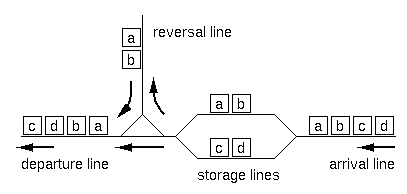POJ-3007 Organize Your Train part II (字符串hash)
2016-06-05 21:36
561 查看
Description
RJ Freight, a Japanese railroad company for freight operations has recently constructed exchange lines at Hazawa, Yokohama. The layout of the lines is shown in Figure 1.

Figure 1: Layout of the exchange lines
A freight train consists of 2 to 72 freight cars. There are 26 types of freight cars, which are denoted by 26 lowercase letters from "a" to "z". The cars of the same type are indistinguishable from each other, and each car's direction doesn't matter either.
Thus, a string of lowercase letters of length 2 to 72 is sufficient to completely express the configuration of a train.
Upon arrival at the exchange lines, a train is divided into two sub-trains at an arbitrary position (prior to entering the storage lines). Each of the sub-trains may have its direction reversed (using the reversal line). Finally, the two sub-trains are connected
in either order to form the final configuration. Note that the reversal operation is optional for each of the sub-trains.
For example, if the arrival configuration is "abcd", the train is split into two sub-trains of either 3:1, 2:2 or 1:3 cars. For each of the splitting, possible final configurations are as follows ("+" indicates final concatenation position):
Excluding duplicates, 12 distinct configurations are possible.
Given an arrival configuration, answer the number of distinct configurations which can be constructed using the exchange lines described above.
Input
The entire input looks like the following.
the number of datasets = m
1st dataset
2nd dataset
...
m-th dataset
Each dataset represents an arriving train, and is a string of 2 to 72 lowercase letters in an input line.
Output
For each dataset, output the number of possible train configurations in a line. No other characters should appear in the output.
Sample Input
Sample Output
Source
Japan 2006 Domestic
题意:将一个字符串可以任意分成两节,任意颠倒顺序,问最终会得到几个字符串。
分析:字符串hash,我没有进行查找判重操作,直接开了一个unsigned ll的set去记录出现过的值。
RJ Freight, a Japanese railroad company for freight operations has recently constructed exchange lines at Hazawa, Yokohama. The layout of the lines is shown in Figure 1.

Figure 1: Layout of the exchange lines
A freight train consists of 2 to 72 freight cars. There are 26 types of freight cars, which are denoted by 26 lowercase letters from "a" to "z". The cars of the same type are indistinguishable from each other, and each car's direction doesn't matter either.
Thus, a string of lowercase letters of length 2 to 72 is sufficient to completely express the configuration of a train.
Upon arrival at the exchange lines, a train is divided into two sub-trains at an arbitrary position (prior to entering the storage lines). Each of the sub-trains may have its direction reversed (using the reversal line). Finally, the two sub-trains are connected
in either order to form the final configuration. Note that the reversal operation is optional for each of the sub-trains.
For example, if the arrival configuration is "abcd", the train is split into two sub-trains of either 3:1, 2:2 or 1:3 cars. For each of the splitting, possible final configurations are as follows ("+" indicates final concatenation position):
[3:1] abc+d cba+d d+abc d+cba [2:2] ab+cd ab+dc ba+cd ba+dc cd+ab cd+ba dc+ab dc+ba [1:3] a+bcd a+dcb bcd+a dcb+a
Excluding duplicates, 12 distinct configurations are possible.
Given an arrival configuration, answer the number of distinct configurations which can be constructed using the exchange lines described above.
Input
The entire input looks like the following.
the number of datasets = m
1st dataset
2nd dataset
...
m-th dataset
Each dataset represents an arriving train, and is a string of 2 to 72 lowercase letters in an input line.
Output
For each dataset, output the number of possible train configurations in a line. No other characters should appear in the output.
Sample Input
4 aa abba abcd abcde
Sample Output
1 6 12 18
Source
Japan 2006 Domestic
题意:将一个字符串可以任意分成两节,任意颠倒顺序,问最终会得到几个字符串。
分析:字符串hash,我没有进行查找判重操作,直接开了一个unsigned ll的set去记录出现过的值。
#include <set>
#include <queue>
#include <vector>
#include <cstdio>
#include <utility>
#include <cstring>
#include <iostream>
#include <algorithm>
using namespace std;
char S[100005];
unsigned long long xl[100005],Hash[100005],Rhash[100005];
int T;
int main()
{
xl[0] = 1;
for(int i = 1;i <= 100000;i++) xl[i] = xl[i-1]*27;
scanf("%d",&T);
while(T--)
{
int ans = 1;
set <unsigned long long> f;
scanf("%s",S);
int n = strlen(S);
Hash
= 0;
Rhash[0] = S[0];
for(int i = n-1;i >= 0;i--) Hash[i] = S[i] + Hash[i+1]*27;
for(int i = 1;i < n;i++) Rhash[i] = S[i] + Rhash[i-1]*27;
f.insert(Hash[0]);
for(int i = 0;i < n-1;i++)
{
if(!f.count(Rhash[i]+Hash[i+1]*xl[i+1]))
{
f.insert(Rhash[i]+Hash[i+1]*xl[i+1]);
ans++;
}
if(!f.count(Rhash[i]+(Rhash[n-1]-Rhash[i]*xl[n-1-i])*xl[i+1]))
{
f.insert(Rhash[i]+(Rhash[n-1]-Rhash[i]*xl[n-1-i])*xl[i+1]);
ans++;
}
if(!f.count(Hash[0]-Hash[i+1]*xl[i+1]+(Rhash[n-1]-Rhash[i]*xl[n-1-i])*xl[i+1]))
{
f.insert(Hash[0]-Hash[i+1]*xl[i+1]+(Rhash[n-1]-Rhash[i]*xl[n-1-i])*xl[i+1]);
ans++;
}
if(!f.count(Rhash[i]*xl[n-1-i]+Hash[i+1]))
{
f.insert(Rhash[i]*xl[n-1-i]+Hash[i+1]);
ans++;
}
if(!f.count(Rhash[i]*xl[n-1-i]+(Rhash[n-1]-Rhash[i]*xl[n-1-i])))
{
f.insert(Rhash[i]*xl[n-1-i]+(Rhash[n-1]-Rhash[i]*xl[n-1-i]));
ans++;
}
if(!f.count((Hash[0]-Hash[i+1]*xl[i+1])*xl[n-1-i]+(Rhash[n-1]-Rhash[i]*xl[n-1-i])))
{
f.insert((Hash[0]-Hash[i+1]*xl[i+1])*xl[n-1-i]+(Rhash[n-1]-Rhash[i]*xl[n-1-i]));
ans++;
}
if(!f.count((Hash[0]-Hash[i+1]*xl[i+1])*xl[n-1-i]+Hash[i+1]))
{
f.insert((Hash[0]-Hash[i+1]*xl[i+1])*xl[n-1-i]+Hash[i+1]);
ans++;
}
}
if(n > 1) cout<<ans<<endl;
else cout<<0<<endl;
}
}
相关文章推荐
- 【leetcode】217. Contains Duplicate
- Yarn公平调度器之DRF算法
- 函数 void main 与 int main 的区别
- Servlet_Filter(过滤器)及FilterChain的使用详解
- 使用wait方法和notify方法用于线程间通信的正确姿势
- 70. Climbing Stairs
- 217. Contains Duplicate
- Maven工程产生Jar时Main-Class和Class-Path的配置文件
- 每天一道算法题——拼音翻译成阿拉伯数字(有Wan,Qian,Bai,Shi单位)
- TensorFlow人工智能入门教程之十四 自动编码机AutoEncoder 网络
- Publishing failed with multiple errors Could not delete *,May be locked by another process.
- FSDataInputStream
- AIDL跨进程回调(Server回调Client)
- 【年度学术大会合集】SIGGRAPH,KDD,AAAI,NIPS…这些你想参加的会议
- 1867 A + B for you again
- Main函数的参数
- 人工智能与信号处理--看知乎问答有感.
- Grails里DOMAIN类的一对一,一对多,多对多关系总结及集成测试
- Facebook发布人工智能产品DeepText:能以人类智商
- "Factorial Trailing Zeroes" and "Pascal's Triangle II"
